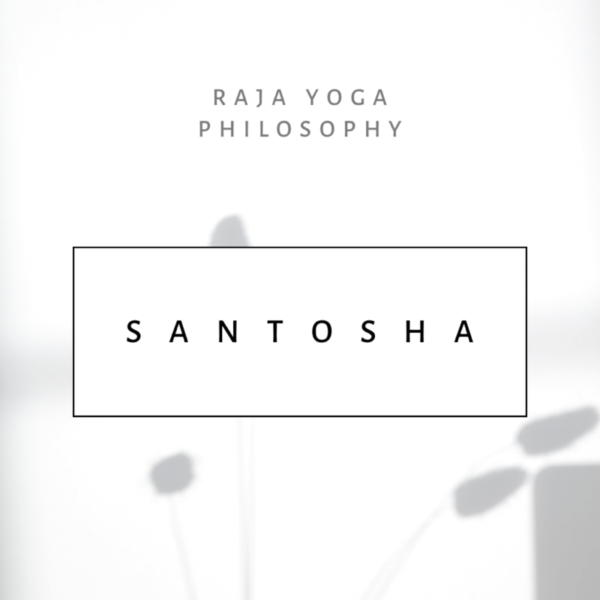Information


In Raja yoga, the 8 limbs of yoga are the steps Sri Patanjali suggests to take for those longing for Moksha/liberation from the ego and attachment to the physical self. The second limb, known as the Nyamas refers to the personal behaviours that we should practice according to Patanjali on the spiritual yogic path.
The 5 Nyamas are:
Saucca – cleanliness
Santosha – contentment
Tapas – austerities
Swadyaya -self-study
Ishwara Pranidhana – surrendering the ego
Whilst I will explain each of these in later blogs, I wanted to focus on Santosha as this in my opinion is something that can be practiced by everyone, not only those who aspire to take on a yogic path.
Santosha refers to contentment, being content with life. But what is contentment? What does it actually mean to be content? Some might say it is to be happy and this makes sense right? But with happiness, sadness will follow at some point, so will this still be a state of contentment?
The way I can explain Santosha is the neutral ground between happiness and sadness. When we search for happiness, we are not exactly practicing Santosha. It means that we see happiness as an external concept outside of ourselves, so we seek it through the physical life experiences and for some, through things. If we have something we want, then we feel happy. If we don’t, then most of the time we are sad because we don’t have it. Whenever we seek happiness, we can learn that with it will always come sadness too. Both are connected, one cannot be without the other. We are happy because we don’t feel sad, and we feel sad because we don’t feel happy.
Santosha comes in between and in my opinion it is the concept of being in contentment and satisfied with what is in this moment. It is neither happiness, nor sadness; it is not dependant on either of those. It is a state of joyful, acceptance and surrender.
In my opinion, we cannot always be happy. There are moments in life when sadness needs to be experienced. And there are also times of complete happiness. But if we learn to practice Santosha, we can experience both without being too attached to either. We can always be in a state of being, simply being.

Finding gratitude for life and all that we are gifted with is one way of practicing Santosha. Even some unpleasant experiences for which we might hold cold feelings such as pain, sadness, guilt, shame, regret etc later on we can maybe understand the lessons that came with that experience because we cannot change what has happened. Being present in the moment, without the mind wondering in the past or rushing towards the future is also a way of practicing Santosha. This is perhaps one of the most important parts of it. When we are present we are here and now. There is nothing else. This does not leave room for any other desires of wanting to change something or wishing for something different. It is what it is and if we can change something, the inspiration for this comes only when we are clear in the mind and open with our heart.
Surrender and acceptance relate beautifully with Santosha. Whilst we might think we can control life, we are more often than not proven differently. It is not about being in control, but learning to surrender to the flow of life without forcing for things to happen. We can try with patience, strength and self-belief to open a door of opportunity, but if that door does not open regardless what we try, perhaps we need to wait for a different time or open another door before that one opens. Everything is in synchronicity with the Divine essence and trusting this requires strength and unshakeable faith.
Yoga is not an easy path. It is not all calm and peachy. It is like a mirror through which we can see every layer of our existence, every part of our being and finally, one day maybe, we can see ourselves, our true self. But this requires so much commitment, dedication, belief and continuous practice. Yet it is the practice itself that can bring us into Santosha. The practice teaches us to be disciplined yet adaptable. We learn to be wise but open with our heart; to express ourselves freely yet to listen more; to free our body from all kinds of tension yet lovingly; to sit in silence and calm yet not to be afraid of the crowds and chaos. All of these, and more are the lessons we get from our sadhana (spiritual practice) which all are to be practiced in our life, throughout our physical existence.
Santosha can happen in every moment. It is a walk by the sea and listening to the sounds of the waves; it is the feeling of allowing raindrops to touch our skin without rushing out of the rain; it is the perseverance we keep when we fall; and the humbleness developed when being of service; it is a quick beautiful connection with a stranger without rushing into the future or analysing where it leads; it is the moment we find steadiness of body and mind through the connection of our breath. Santosha is also in the times when we fall and we recognise the power in rising again. It is in the tough periods of mourning and grief yet we fill our heart with gratitude and joy for having had special moments together, regardless how long they lasted. It is in the experiences of darkness yet we acknowledge the depth of light, the true power of illumination.
Santosha is the moment we open our eyes in the morning and no matter what we say “Thank you for giving another opportunity to be of service, to be useful, to love, to feel loved, to experience whatever comes because I trust and I am open to learn”.